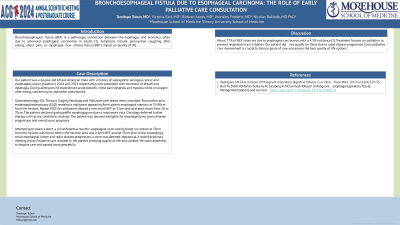Sunday Poster Session
Category: Esophagus
P0538 - Bronchoesophageal Fistula Due to Esophageal Carcinoma: The Role of Early Palliative Care Consultation
Sunday, October 27, 2024
3:30 PM - 7:00 PM ET
Location: Exhibit Hall E

Has Audio
- TT
Temitope Tobun, MD
Morehouse School of Medicine
Atlanta, GA
Presenting Author(s)
Temitope Tobun, MD1, Victoria Earl, MD2, Ridwan O. Azees, MD3, Jhonsley Frederic, MD1, Nicolas Bakinde, MD, PhD1
1Morehouse School of Medicine, Atlanta, GA; 2Emory University School of Medicine, Atlanta, GA; 3Morehouse School of Medicine, Oklahoma City, OK
Introduction: Bronchoesophageal fistula (BEF) is a pathologic connection between the esophagus and bronchus, often due to advanced esophageal carcinomas in adults [1]. Symptoms include paroxysmal coughing after eating, chest pain, or dysphagia. Few articles discuss BEF's impact on quality of life.
Case Description/Methods: Our patient was a 64-year-old African American male with a history of supraglottic laryngeal cancer and esophageal cancer (treated in 2014 and 2023 respectively), who presented with shortness of breath and dysphagia. During admission, he experienced acute pleuritic chest pain, dyspnea, and hypoxia while on oxygen after eating, concerning for aspiration pneumonitis.
Gastroenterology (GI), Thoracic Surgery, Oncology, and Palliative care teams were consulted. Two months prior, esophagoduodenoscopy (EGD) revealed a malignant appearing 8mm patent esophageal stenosis at 35-40cm from the incisors. Repeat EGD this admission showed a new small BEF at 33cm and ulcerated tissue from 30 to 35cm. The patient declined gastrograffin esophagogram due to respiratory risks. Oncology deferred further therapy until acute conditions resolved. The patient was deemed ineligible for esophagectomy given disease progression and overall poor prognosis.
Attempting to place a stent, a circumferential necrotic esophageal ulcer oozing blood on contact at 30cm from the incisors was found. Within the necrotic area was a 6mm BEF around 33cm. Due to the exceedingly small esophageal lumen and rapid disease progression, a stent was deemed impractical. A multidisciplinary meeting led by Palliative care resulted in the patient choosing quality of life and comfort. He was transferred to hospice care and passed away peacefully.
Discussion: About 77% of BEF cases are due to esophageal carcinomas, with a 4.5% incidence [2]. Treatment focuses on palliation to prevent respiratory tract irritation. Our patient did not qualify for these due to rapid disease progression. Early palliative care involvement is crucial to discuss goals of care and ensure the best quality of life options.
Disclosures:
Temitope Tobun, MD1, Victoria Earl, MD2, Ridwan O. Azees, MD3, Jhonsley Frederic, MD1, Nicolas Bakinde, MD, PhD1. P0538 - Bronchoesophageal Fistula Due to Esophageal Carcinoma: The Role of Early Palliative Care Consultation, ACG 2024 Annual Scientific Meeting Abstracts. Philadelphia, PA: American College of Gastroenterology.
1Morehouse School of Medicine, Atlanta, GA; 2Emory University School of Medicine, Atlanta, GA; 3Morehouse School of Medicine, Oklahoma City, OK
Introduction: Bronchoesophageal fistula (BEF) is a pathologic connection between the esophagus and bronchus, often due to advanced esophageal carcinomas in adults [1]. Symptoms include paroxysmal coughing after eating, chest pain, or dysphagia. Few articles discuss BEF's impact on quality of life.
Case Description/Methods: Our patient was a 64-year-old African American male with a history of supraglottic laryngeal cancer and esophageal cancer (treated in 2014 and 2023 respectively), who presented with shortness of breath and dysphagia. During admission, he experienced acute pleuritic chest pain, dyspnea, and hypoxia while on oxygen after eating, concerning for aspiration pneumonitis.
Gastroenterology (GI), Thoracic Surgery, Oncology, and Palliative care teams were consulted. Two months prior, esophagoduodenoscopy (EGD) revealed a malignant appearing 8mm patent esophageal stenosis at 35-40cm from the incisors. Repeat EGD this admission showed a new small BEF at 33cm and ulcerated tissue from 30 to 35cm. The patient declined gastrograffin esophagogram due to respiratory risks. Oncology deferred further therapy until acute conditions resolved. The patient was deemed ineligible for esophagectomy given disease progression and overall poor prognosis.
Attempting to place a stent, a circumferential necrotic esophageal ulcer oozing blood on contact at 30cm from the incisors was found. Within the necrotic area was a 6mm BEF around 33cm. Due to the exceedingly small esophageal lumen and rapid disease progression, a stent was deemed impractical. A multidisciplinary meeting led by Palliative care resulted in the patient choosing quality of life and comfort. He was transferred to hospice care and passed away peacefully.
Discussion: About 77% of BEF cases are due to esophageal carcinomas, with a 4.5% incidence [2]. Treatment focuses on palliation to prevent respiratory tract irritation. Our patient did not qualify for these due to rapid disease progression. Early palliative care involvement is crucial to discuss goals of care and ensure the best quality of life options.
Disclosures:
Temitope Tobun indicated no relevant financial relationships.
Victoria Earl indicated no relevant financial relationships.
Ridwan Azees indicated no relevant financial relationships.
Jhonsley Frederic indicated no relevant financial relationships.
Nicolas Bakinde indicated no relevant financial relationships.
Temitope Tobun, MD1, Victoria Earl, MD2, Ridwan O. Azees, MD3, Jhonsley Frederic, MD1, Nicolas Bakinde, MD, PhD1. P0538 - Bronchoesophageal Fistula Due to Esophageal Carcinoma: The Role of Early Palliative Care Consultation, ACG 2024 Annual Scientific Meeting Abstracts. Philadelphia, PA: American College of Gastroenterology.
